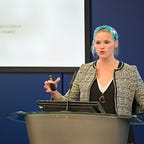Your City: Updating
How digital technology is changing our cities one small update at a time (2019)
Originally published via LinkedIn on October 25, 2019.
Every day, new digital products and solutions come into this world. Smart phones. Intelligent lampposts. Autonomous vehicles. Multifunctional sensors. Faster networks. Better software. Stronger connectivity.
Every day, everywhere, people are asked to consider whether to buy, upgrade, install, download, lease, procure, postpone, or ignore the adoption of new technology. In answering these questions, we make minor transformative decisions for ourselves — install updates, accept cookies, download software — that together determine the digital augmentation of our lives, and the terms and conditions we succumb to.
Yes, smart energy meter, you may monitor my daily routines if you help me reduce my yearly bill. No, way-finding app, I would rather type in my location manually than share my whereabouts with you at all times.
As individuals, we have a sense of control, however minimal and hastily flouted. But what happens when the software is being downloaded not onto my laptop, but onto my street’s energy grid? What happens when sensors are installed not in my fridge, but in my public plaza? What happens when my decision to order groceries via an airborne delivery drone impacts my neighbour’s sense of privacy, as the propeller churns above our semi-detached properties?
When it comes to public space, how do we collectively determine the ideal level of digital augmentation?
While citizens come to terms with their personal levels of comfort around increasingly smart objects and services, public authorities grapple with similar questions on a much larger scale and with broader societal repercussions — because when civil servants judge one technology over the other, sign up to a service provider, or impose regulatory measures, they are effectually opting in on behalf of all of us.
Of course, the purpose of a public authority is to make these sorts of decisions, particularly in a democratic society; we cannot vote on every single update, so we elect representatives to mirror our personal views. The problems arise when neither our personal views nor the political platforms are very clear, as is often the case when the debate turns to ‘smart cities’*.
Topics and challenges relating to urban technology are so new that most of us have hardly had a chance to discuss them around the dinner table, let alone in a public forum. The centuries of conversations that have taken place on subjects such as housing, mobility, and employment, simply haven’t yet matured on digital infrastructure in order to form a public voice. From Airbnb’s rental revolution, to Lime’s swarm of scooters, to WeWork’s cohort of co-workers, even previously familiar aspects of our lives are being disrupted and uprooted at a pace hitherto unexperienced, with little time to reflect on the implications.
How can we expect policy makers to look out for our best interests through this digital transformation, when we have yet to define where our interests lie?
Looking to cities around the world, it is fascinating to see the breadth of approaches that are developing as a result.
In Copenhagen, Uber was pushed out by a series of new laws that made the business model untenable; instead, the streets have been populated by privately-run shared electric scooters (which will soon also be regulated). In the UK, electric scooters are currently only allowed on private land, so here regulations are likely to be slackened to widen people’s mobility choices and help combat serious air pollution challenges in inner cities. New York City has implemented public free WiFi in most neighbourhoods. Basel in Switzerland sources 100% of the city’s electricity from renewable energy sources. In Zhengzhou, China, police officers are being equipped with facial recognition software to help identify criminals in the city’s main train station, a technology which San Francisco has completely banned from public space. Las Vegas turned to Cisco to build a smart city platform, Rio de Janeiro to IBM.
It would be great to think that this fragmented picture of urban technology is reflective of the diverse opinions of each local community. Unfortunately, that rarely seems to be the case (at least not intentionally). For the amount of digital solutions, there is an incredible lack of digital strategies, let alone strategies based in actual citizen engagement and user research.
Luckily, there are also some examples where authorities have taken a more transparent and democratic approach to shaping the digital agenda. In Melbourne, the City-run libraries regularly serve as public venues for learning and debating new technologies, while the annual Knowledge Week is hosted for the sole purpose of bringing together Melburnians to explore, discuss, and ideate the future together. Meanwhile, Barcelona Digital City has published the Ethical Digital Standards as an open source policy toolkit for cities to develop people-centric digital policies. With this, and many other initiatives, Barcelona is committed to creating a people’s roadmap towards technological autonomy.
We need more examples like these, where the purpose is first and foremost to start a conversation, then to define outcomes, and lastly to implement solutions. With a more strategic, focused, and people-centred approach, the smart cities of tomorrow could be every bit as sustainable, liveable, and diverse as we desire — one thoughtful update at a time.
*A smart city is defined here simply as a place that uses digital technology in one form or another to deliver more efficient and better civic services.
